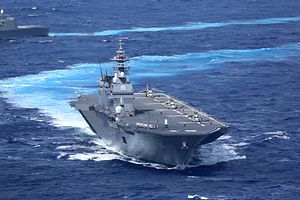The Japan Maritime Self-Defense Force’s (JMSDF) largest warship, the so-called helicopter destroyer JS Izumo, the lead ship of the Izumo-class, will be converted into an aircraft carrier capable of launching the F-35B–the U.S. Marine Corps variant of F-35 Joint Strike Fighter capable of vertical or short takeoffs and vertical landings (STOVL) without requiring a catapult launcher—from its flight deck, according to Japan’s new draft defense plan presented on December 11.
The revised version of the National Defense Program Guidelines (NDPG), which set out Japan Self Defense Force (JSDF) capability targets over a period of about 10 years, stated that the government will “enable fighter jets to be operated from existing warships, if necessary, to improve the flexibility of their operation.” The NDPG furthermore re-designates the JS Izumo as a multi-purpose escort destroyer to comply with Japan’s pacifist constitution that limits JSDF capabilities to self-defense.
“The Izumo was originally designed as a multipurpose escort ship, so it wouldn’t pose any threat to other countries if fighter jets are deployed on it,” Defense Minister Takeshi Iwaya was quoted as saying by The Japan Times on December 11. Iwaya also reiterated that the warship would not be an “attack aircraft carrier” capable of offensive military operations. Furthermore, to assuage its junior coalition partner, Komeito, the ruling Liberal Democratic Party stressed that the F-35Bs operating from the JS Izumo’s flight deck cannot serve as long-distance attack platforms given that the JSDF lacks mid-air refueling capabilities. Additionally, no F-35B squadron is expected to be permanently assigned to the new carrier.
As I reported in May, a study conducted by the Izumo’s builder, Marine United Corporation (MUC), earlier this year concluded that warship, along with its sister ship, JS Kaga, can be turned into aircraft carriers. The carrier has reportedly been designed to operate STOVL fighter jets all along and requires only minor modifications to accommodate the F-35B. As I wrote in February:
[A] consensus was privately reached at the inception of the Izumo project that the warships should be designed allowing for a future conversion into an F-35B-carrying naval platform. (…)
Modifications on the Izumo-class, among other things, would require the installation of a ski-jump. Contrary to earlier reports, (…) [the] flight deck has already been coated with paint that can withstand the exhaust heat generated during F-35B landings and takeoffs. Additionally, the aircraft elevators, connecting the flight deck with the hangar, were reportedly specifically designed to accommodate the F-35B.
Modifications would nonetheless take some time. While the 27,000-ton Izumo-class is the biggest warship class in service with the JMSDF since the end of World War II, it would likely carry only around a dozen or fewer F-35Bs. The JMSDF will also need to quickly build up expertise in carrier operations, which as the experience of the People’s Liberation Army-Navy has shown, can be a long and painful process.
To date, the Izumo-class’ biggest asset for Japanese naval power is its sophisticated anti-submarine warfare (ASW) capability. Its usefulness as an ASW platform would be substantially reduced following the ship’s conversion as it would no longer be capable of carrying its full contingent of Mitsubishi-built SH-60k ASW helicopters and other ASW-related equipment. “The ship is designed to accommodate up to 14 helicopters (seven Mitsubishi-built SH-60k ASW helicopters and seven AgustaWestland MCM-101 mine countermeasure helicopters), five of which can simultaneously take off and land, given the Izumo’s large flight deck and five landing spots,” I explained previously.
The Cabinet of Japanese Prime Minister Shinzo Abe plans to endorse on revised version of the NDPG on December 18.
































